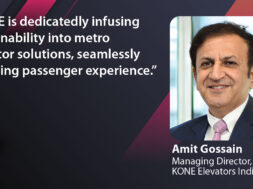There is more to smart lighting than just illumination

Smart lighting can help you manage lighting diagnostics, lower costs, operate more efficiently and connect your lighting systems using standard networking and communications technologies, says Sumit Joshi, Vice Chairman and Managing Director, Signify Innovations India.
In the Smart City India initiative so far, what are some of the novel examples of smart lighting? The Indian government has committed to developing 100 smart cities and smart lighting is a big part of that agenda. Street lighting transformation has been accelerated by the advent of government’s initiatives like UJALA, the smart cities mission and the Street Lighting National Program (SLNP). These programs are aimed at mitigating climate change by reducing the overall energy consumption of lighting that helps DISCOMs to manage peak demand. SLNP is the world’s largest streetlight replacement program and UJALA is the world’s largest domestic lighting project.
Signify is proud to be a part of the first public-private partnership of this kind in India, with our project in Pune using our interact city solution. “Our vision is for Pune to become a smart city, transforming the lives of residents using technology,” Kunal Kumar, Joint Secretary & Mission Director in the Ministry of Housing and Urban Affairs, had said just before the launch. The project saw 80,000 halogen streetlights being replaced with energy-saving LED luminaires. Our interact city solution helped increased visibility on roads, reduced lighting downtime and helped citizens feel safer at night.
The best part however was that the project funding was realized by using the energy savings and reduced maintenance costs that were achieved through the project. Thanks to our technology, Pune city authorities can now control groups of lights remotely, resulting in up to 40 per cent energy savings. This partnership between Pune city and Signify shows that increased safety and energy efficiency need not result in additional costs for the city administration. It also shows that community empowerment can be both a way of working and an outcome of a well-designed and executed project. Similarly, in Delhi, we partnered with the New Delhi Municipal Corporation(NDMC), replacing their 6,000 conventional streetlights with our Philips CityTouch ready Smart Street light System, enabling the municipal body to remotely monitor their street lighting infrastructure.
What exactly makes lighting “smart”? What kind of technologies comes into play?
Smart lighting is based on the concept that lighting can do and should do more than just illumination. The transition of lighting from incandescent to LED helped to enable this technology, as LEDs can be digitally controlled. Therefore, smart lighting can help you manage lighting diagnostics, lower costs, operate more efficiently and connect your lighting systems using standard networking and communications technologies.
Here are the elements that come into play when bringing a smart lighting project to life:
Hardware: Connected luminaires are just the beginning. Urban IoT projects often need access to deep expertise in other IoT devices as well. These include sensors, cameras, microphones, and navigation equipment.
Software: Smart lighting initiatives require a comprehensive IoT platform that provides a consistent and scalable base for both pilot projects and initiatives no one’s thought of yet. For instance, in a smart street lighting project, you need comprehensive control dashboards for managers, and possibly advice on developing the user-facing apps those managers can use to administer the project day to day.
Communications and network infrastructure: A smart lighting ecosystem needs reliable connectivity and adequate bandwidth to thrive. This can be a mix of cellular, small cell, Wi-Fi, and short-range IoT communications to ensure consistent and smooth communications.
Data storage and analysis: A well-equipped smart lighting project such as a smart street lighting project generates a wealth of information that city managers can use to improve the quality of life for citizens. Sensor data indicating when streets are heavily trafficked and when they aren’t can of course lead to more intelligent provision of lighting to certain areas of town – luminaires can dim when no one’s around, thus saving energy. But there’s much more: Sensor data on air quality can help guide public health initiatives. Data on traffic patterns, parking habits, peak congestion hours, and even wind speeds and humidity levels can help drive municipal initiatives that have the potential to improve the overall quality of life for its citizens.
Power grid and utilities: In many cities, lighting is already delivered in partnership with, or as a service by, utility or grid operators. The municipality’s relationships with these operators have typically originated in an era of lower-tech lighting. Those relationships may thus need amending in the current scenario. Working with partners who understand the services that grid operators have provided can be valuable. Firstly, it can help reshape the project’s cost structure for the better and secondly, it can lead to the proper allocation of responsibilities between power companies and civic offices.
Systems integration: A systems integrator who has the requisite experience with your chosen connected lighting apparatus, your IoT platform, your enterprise data repository, and your network providers can help reduce implementation times and shorten time to benefit. Apart from cities and municipalities, how does this concept help the grid operators or private partners?
Lighting asset management: It can enable them to easily commission new and existing lighting assets, detect faults, and remotely monitor energy and performance. They also get to gain data-based insights into city lighting so that they can respond quickly to real-time alerts.
Energy optimization: It helps them optimize street lighting performance and accurately measure energy usage in real-time. Full control of your city lighting lets you reduce CO2 emissions, make progress toward your sustainability goals, and lower energy usage and costs, thereby allowing you to reinvest the savings to improve other areas of your city’s infrastructure.
Scene management: Public lighting used to come in two settings: on and off. Not anymore. Now you can remotely adapt city lighting to the time of night, season or event. You can increase lighting in an area where an accident or crime incident is happening or you can even dim the intensity to 30 per cent in the middle of the night when nobody is around. Smart dynamic lighting can also help enhance tourism and nightlife by turning parks and plazas into memorable, livable spaces.
Connectivity for the ecosystem: Open APIs enable integration with other city dashboards and applications. Participating in private partners and third parties can also be permitted to access lighting control functionality or enable data synchronization with other IT systems.
7
Cookie Consent
We use cookies to personalize your experience. By continuing to visit this website you agree to our Terms & Conditions, Privacy Policy and Cookie Policy.









